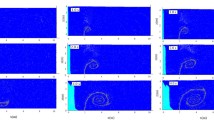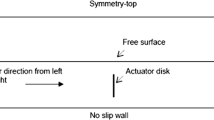Abstract
In this paper, simulation of oil spill due to tidal currents in Persian Gulf is performed by coupled solution of the hydrodynamics equations and an equation for convection and diffusion of the oil. The hydrodynamic equations utilized in this work consist of depth average equations of continuity and motion in two dimensional horizontal planes. The effect of evaporation is considered in the continuity equation and the effects of bed slope and friction, as well as the Coriolis effects are considered in two equations of motion. The overlapping cell vertex finite volume method is applied for solving the governing equations on triangular unstructured meshes. Using unstructured meshes provides great flexibility for modeling the flow in arbitrary and complex geometries, such as Persian Gulf flow domain. The results of the hydrodynamic model for tidal currents in Persian Gulf domain is examined by imposing tidal fluctuations to the main flow boundary during a limited period of time. Finally, the developed model is used to simulate an accidental oil spill from a point in Persian Gulf.
Similar content being viewed by others
References
ASCE, Task Committee on Modeling Oil Spills of the Water Resources Engineering Division, (1996). State of the art review of modeling transport and fate of oil spills, Journal of Hydraulic Engineering, 122, 594–609.
Castanedo, S., Medina, R. and Mendez, F. J., (2005). Models for the turbulent diffusion terms of shallow water equations, J. Hydro. Eng., ASCE, 131(3), 217–223.
Clark, R. B., (1992). Marin Pollution, 3rd Ed., Gookcraft Ltd., UK., 50–60.
Haung, J. C., (1983). A review of the state of the art of the oil spill behavior models, Proceeding of Oil Spill Conference, Washington DC., API, 313–322.
Jameson, A., Baker, T. J. and Weatherill, N. P., (1986). Calculation of inviscid transonic flow over a complete aircraft, American Institution of Aeronautics and Astronautics (AIAA)Paper No. 86-0103.
Jameson, A., Schmidt, W. and Turkel, E., (1981). Numerical solution of the euler equations by finite volume method using Runge-Kutta time stepping schemes, American Institution of Aeronautics and Astronautics (AIAA) Paper No. 81-1259.
Lehr, W. J., Cekirge, H. M., Fraga, R. J. and Belen, M. S., (1984). Empirical studies of the spreading of oil spills, Oil Petrochem. Pollut., 2, 7–11.
Mackay, D., Paterson, S. and Trudel, K., (1980). A mathematical model of oil spill behavior, Report No. EE-7, Fisheries and Environment, Environmental Protection Service, Canada.
Najafi, H. S., Noye, B. J., Teubne,r M. D., (1995). Spherical-coordinate numerical model of the Persian Gulf, Computation Techniques and Applications, CTAC-95, World Scientific. Electronic proceeding publication. Available at: http://www.csc.fi/math_topics/Mail/NANET95/msg00203.html
Reed, M., Johansen, O., Brandvik, P. J., Daling, P., Lewis, A., Fiocco, R., Mackey, D. and Prentki, R., (1999). Oil spill modeling toward the close of the 20th. century: Overview of state of the art, Spill Science and Technology Bulletin, 5, 3–16.
Report on Rainfall and surface currents in Iran, (2003), Water Resource Management Organization of Iran, Ministry of Energy, Research Deputy (Farsi).
Sabbagh-Yazdi, S. R. and Mohammadzadeh, M., (2004). Finite volume solution of two-dimensional convection dominated sub-critical flow using unstructured triangular meshes, Int. J. Civil Eng., 2(3), 78–91.
Spaulding, M. L., (1988). A State of the art review of oil spill trajectory and fate modeling, Oil. Chem. Pollut., 4, 39–55.
Stolzenbach, K. D., Madsen, O. S., Adams, E. E., Pollack, A. M. and Cooper, C. K., (1977). A review and evaluation of basic techniques for predicting the behavior of surface oil slicks. Report No. 222, Ralph M. Parsons Laboratory for Water Resources and Hydrodynamics, Department of Civil Engineering, MIT, USA.
Thompson, J., Soni-Bharat, F., Weatherill, F. and Nigel, P., (1999). Hand book of grid generation, CRC Press, Sec. 26, New York, USA.
Tkalich, P., Huda, K. and Hoong-Gin, K. Y., (2003). A multiphase oil spill model, J. Hydro. Res., 1(2), 115–125.
Vreugdenhil, C. B., (1994). Numerical methods for shallow water flow, Kluwer Academic Publisher: 15–46.
Author information
Authors and Affiliations
Corresponding author
Rights and permissions
About this article
Cite this article
Yazdi, S.R.S. Coupled solution of oil slick and depth averaged tidal currents on three-dimensional geometry of Persian Gulf. Int. J. Environ. Sci. Technol. 2, 309–317 (2006). https://doi.org/10.1007/BF03325891
Received:
Revised:
Accepted:
Published:
Issue Date:
DOI: https://doi.org/10.1007/BF03325891




